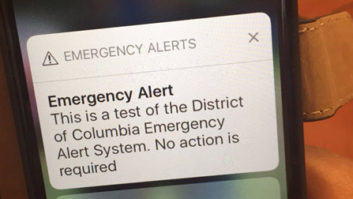Associated Broadcast Consultants provided the above predicted coverage map for the Solent Wireless transmitter at Fort Widley.
As reported recently in DRU, the �mini-mux� in Portsmouth, England, has recently celebrated its first year of being on-air.
DAB operates as an ensemble of different radio services, known in the UK as a multiplex and operated by a multiplex owner. Most local DAB multiplexes operate over a broadcast area designed to cover one or many heritage FM broadcast areas; and typically these multiplexes are single frequency networks with multiple transmission facilities to ensure a consistent quality of reception. The multiple transmission sites, and requirement for carefully synchronised broadcasts on a SFN, come with significant costs.
A year ago, Ofcom, the UK broadcast regulator, licensed an amount of trial, �small-scale� DAB multiplexes at lower signal strengths. These were seen as opportunities for smaller broadcasters to get onto digital at lower cost. Solent Wireless applied for a licence for Portsmouth, a city on the south coast of England. The area covered has a population of 300,000.
The existing DAB multiplex covering the area is designed to cover a much larger footprint of 1.2m people, and has six transmission sites. The transmitter covering Portsmouth runs a power of 0.33 kW ERP.*�
I spoke with Ash Elford, the Digital Development Manager of Angel Radio, the company that operates the mini-mux as �Solent Wireless�. I learnt that, in contrast, their multiplex runs at 0.2kW ERP. They use an antenna with 6dB gain, which, according to Elford means they can run a lower-powered amplifier, and that they cause very little adjacent channel interference.
A significant cost of a traditional multiplex is getting the radio station�s audio to the multiplex operator in the first place. For Solent Wireless, this is a place where savings can be made. �Stations get their audio to us over the public internet,� says Elford. �It works very well. Some stations have fibre connections, but there are a few on ADSL. It holds up�, he adds.
Use of the public internet extends to the transmission site, which uses wireless internet with a QOS to ensure reliability. Indeed, at least one station on the multiplex is entirely cloud-based, using Amazon Web Services for everything, including the playout system.
While there are ten trial mini-muxes of this type currently running, Solent Wireless appear to be the most innovative, adding DAB+ services and slideshow to broadcasts. �It appears that in the real world, we�ve found quite a few DAB sets support DAB+ without explicitly saying so,� says Elford. �Running DAB+ allows us to include as many different formats as possible whilst maintaining good audio quality. It appears that those stations who have launched in DAB+ or have converted to it have good numbers of interactions from listeners.�
However, some innovations may be a little ahead of their time. �We have slideshow running on nearly all of our services, but there�s been no feedback from listeners acknowledging its existence. But our philosophy is that, as some radios support it, and we can do it, we should do it.�
The low cost of these multiplexes is an important part of the trial, though Elford highlights that low cost is �not the same as no cost. We have to pay rental on our TX site, insurance, telecoms and maintain a float of spares, and these costs have to be passed on. But despite this, the main [non-content] costs for our broadcasters are fees from Ofcom and [music collection societies] PRS and PPL.�
These mini-multiplexes appear to be well received by broadcasters and the public alike, and many new trial formats have appeared. The day after I spoke to Solent Wireless, they announced a new, all-weather radio station, Weather 24/7: possibly the most British format you could think of. But whatever the weather, with new mini-muxes pushing technical boundaries, the outlook for British DAB listeners is bright.
�
*An earlier version of this article originally mis-stated the power level as 90 kW ERP.�We have now corrected our error, as pointed out by reader Glyn Roylance.
�












